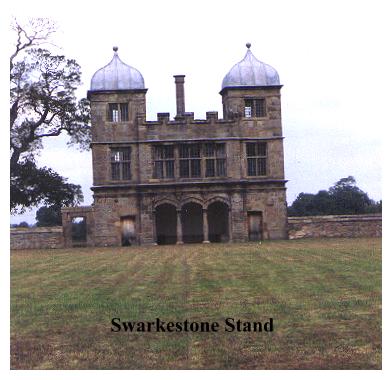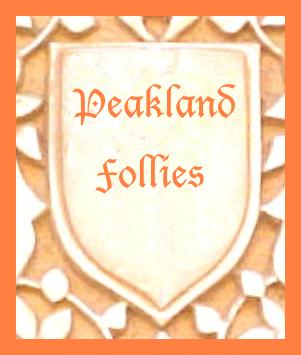14. SWARKESTONE STAND
A short stroll over arable fields twixt River and Canal, to see a curious building of uncertain purpose.
Getting There: Take the A6132 southwards from Derby. Beyond Chellaston the road crosses a railway line and a canal. Just before reaching Swarkestone and the junction with the A514, turn off left onto a small track by an ornamental gateway. This leads to Swarkestone church, where there is just space to park.
Distance: 1 mile (approx)
Map ref: SK 372 286
Rating: Walk * Follies and General Interest **
NOTE: this easy walk may be undertaken as an appetiser for walk no.6 at Foremark, which is just a few miles down the road. Both walks may easily be accomplished in one day.
Swarkestone is an interesting though somewhat neglected place. Cut off to the north by the Trent and Mersey Canal and the railway line and to the south by the swift and gloomy waters of the mighty Trent, Swarkestone is a community astride a junction of busy roads where many pass through, but few linger. Our walk starts by Swarkestone Church.
From the church, pass over the stile and turn right, walking along the edge of the field to join a farm track by the old barn (private house). On the left is the Balcony Field and Swarkestone Stand.

This curious arena dates from 1630, and authorities differ as to whether it was used for bull baiting, deerslaying or some other purpose (possibly bowling or jousting). Some say it was the tournament field depicted by Scott in Ivanhoe, but this seems unlikely as there are other, more respectable claimants to the title! Certainly it seems probable that the letting of blood went on here at some time. It was built for Sir John Harpur of Swarkeston Hall, a great house demolished after the Civil War, and the building is attributed to one Robert Smythson.
The Stand (or Grandstand) had a fireplaced room upstairs and an arched loggia beneath. One tower contained the staircase and the other a privy for the use of the spectators. The adjacent (almost square) enclosure, with its high stone wall, was built by one Richard Shepherd, Stonemason, in 1630, at a cost of £11 12s and 4d! At that time it was referred to as a 'Bowl Alley House.' This may have been so but other researchers agree that this 'cuttle' was almost certainly where the deer were driven, prior to being killed at close range by keepers or honoured guests, suitably armed for the purpose. Alternately they would be pulled down by Sir Johns hunting dogs, such cruel spectacles being the delight of lords and ladies alike in those far off days. It has also been called a summer house, a jousting tower, and a banqueting hall. Perhaps it has been used for all those purposes down the years. It has now been restored by the Landmark Trust, and actually may be rented for short stays as a holiday home!
Beyond the Stand do not follow the track around to the right, but instead continue onwards, passing through a waymarked gate and following a well defined route which passes through a cornfield, leaving it by a footbridge over a small brook. Beyond the footbridge the path becomes rather indistinct. Bear right, following the fieldside until a track appears beyond the second field leading up left to a footbridge on the canal. The canal, The Trent and Mersey, runs ninety three miles from the Bridgewater Canal at Preston Brook, to eventually join the Trent at Derwent Lock near Nottingham. The canal was built by James Brindley, who called it the Grand Trunk Canal. Here at Swarkestone it joined with the Derby Canal, now disused. Among the many canals it connects up with is the Macclesfield (See walk 8, MOW COP.), which it joins at Hardingswood near Kidsgrove. Now turn left onto the towpath and follow it to the next bridge where we turn left up onto the main road. Follow the road a short distance, until the gravel track leading past Swarkestone Stand appears on the left. From the gate, an indistinct path leads diagonally across the field back to the stile by the church. If time permits the pub in Swarkestone my be visited, and, if you don't mind dodging the heavy traffic, it is well worth a stroll down to old Swarkestone Bridge, which stands high and dry beyond the present course of the River Trent. This ancient bridge, reputedly built by two sisters whose lovers drowned trying to get over the river, was the point at which Bonnie Prince Charlie, unnerved by the lack of support he had received on his march south, and having a spy in his camp, who conned him into believing he was marching straight into the jaws of the Duke of Cumberlands redcoats, made the fatal decision to turn back; taking a course of action which was to lead to destruction defeat and exile. It seems odd to think that such a great moment in history happened at this seemingly insignificant spot, ignored and unnoticed by the endless stream of traffic that rumbles by on its way south.







